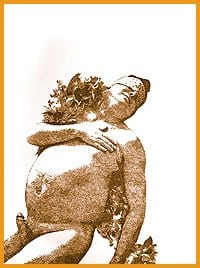In what is likely the gayest thing to appear at Hart House since higher-ups put an end to the bathroom sex, the Justina M Barnicke Gallery presents a big, gay art show called Le Corps Gay/The Gay Body. Initially exhibited at Centre d’Exposition du Vieux Palais, in Saint-Jérôme, Quebec, The Gay Body is an exhibition featuring the work of 22 artists from Toronto, Montreal and Quebec City.
According to the Montreal-based curator, Karl-Gilbert Murray, “The main objective of The Gay Body is to demonstrate how the sexuality of gay men is manifested in contemporary art.” In other words, it is a big, gay art show. The problem with trying to cover so much ground is knowing where to start – or finish. With so many artists having so many different things to say, pulling together a coherent collection is a tricky endeavour. But maybe that’s beside the point. As Murray states in the catalogue essay, “This exhibition is intended to help demystify the strategies used to identify and recognize the gay body in visual representations.” In other words, it is a big, gay art show. Get the picture?
When Murray states, “To exhibit the gay body recognizes and promotes awareness of a certain form of sensibility specific to gay artists,” why should we believe him? Is there really such a sensibility artists share just because they are gay? It seems too reductive to suggest with any authority that they do. The catalogue essay gets more confusing the further along you go. I feel like something has been lost in translation. Or maybe I am just annoyed because I never got asked to put work in the show.
The Gay Body is loosely broken up into four thematic groups. Where one group ends and another begins is unclear, but there are handy text panels to help viewers along. “The Masked Body: The Transvestite, The Cowboy And The Leather Man;” “The Performed Body: Daily Acts And Practices;” “The Suffering Body: HIV/AIDS;” and “The Exhibited Body: The Masculine As Signified” are the categories Murray feels are useful to describe recurring themes. Each section could be a whole show on its own. However, since they are not, the exhibition reads as a survey.
Overall, there are enough well-known artists in The Gay Body to catch people’s attention and get them to the gallery. A few highlights include works by Hamish Buchanan, Matthew Dayler, Evergon and Angela Grossman. Buchanan exhibits a selection of photographs from his Veiled Men series. These photos, as their title suggests, are of men wearing assorted veils (of the nonbridal variety). The men appear in states resembling something like sleep or catatonia. They look exhausted, mournful and alone. Despite their sadness, the photographs are a pleasure to look at. It’s nice to see them in a group. Together they have more weight and context than many of the single works throughout the gallery.
Dayler has two works that, at first glance, appear to be large scale photocopies. They are pen and ink drawings of a rotund, naked man wearing a feather boa and blindfold. Dayler’s drawings are a welcome contrast to the imagery of hard, idealized bodies that many artists in The Gay Body play with. This man, referred to as David 1 and 2, appears blissful and at ease as though he were alone. His head tilts back while his belly and erection jut forward. His contentedness is enviable.
One of the more humorous parts of The Gay Body is an installation piece, Gunfight At The OK Corral, by Montreal’s Evergon. Gunfight is comprised of several pairs of cowboy boots with underwear around their ankles. The boots are arranged circle-jerk style, with a piece of bread in the centre. Gunfight evokes wonderfully pornographic imagery without even showing the viewer a body. While standing near the boots it is surprisingly easy to imagine a group of men racing toward orgasm, hoping to not be the last one stuck eating the bread. Anyone hungry?
Son Of Man by Vancouver’s Angela Grossman is one of few works in The Gay Body made by a woman. Her oil on mylar painting of two men is quiet and sensual. One of the nice things about Son Of Man is its ambiguity. The nature of the relationship between the two men, aside from horizontal and vertical positions, is unclear. It is equally reasonable to assume the figures are lovers as it is to assume they are father and son. Nothing much is really happening in the painting, but that seems to be the point – to take in the moment.
Whenever so many artists are involved in an exhibition, picking out similarities seems arduous. As The Gay Body itself shows, intentionally or not, just because a group of artists are gay does not mean they share the same concerns. Unfortunately for the show as a whole, much of the work in The Gay Body seems to be floating anchorless. The singular works, exciting or not, often lack dialogue with other pieces that strengthen and encourage their artistic language. The Gay Body seems jumbled. Selecting fewer artists, and concentrating the focus of the exhibition would have been more rewarding. But then again, no one asked me.
* Le Corps Gay/The Gay Body continues at Justina M Barnicke Gallery (7 Hart House Circle) until Thu, Dec 9; call (416) 978-8398.

 Why you can trust Xtra
Why you can trust Xtra


